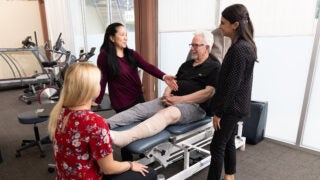- First-gen students lead USC class with record numbers.
- LAUSD’s Foshay Learning Center sends more students to USC than any other high school.
- A leader in transfers, community college and military-connect students.
- After expanding to east Los Angeles, USC NAI sent its largest cohort in 30 years to USC.
Contact: Ron Mackovich, rmackovi@usc.edu or USC Media Relations uscnews@usc.edu
First-gen students make up 22% of this year’s 3,460 freshmen, USC’s largest incoming class ever.
“These students represent the values that USC holds high,” said Tim Brunold, USC Dean of Admission. “Thanks to our abundant financial aid pool, we can bring more remarkably talented students from all backgrounds to USC.”
Public schools top the list
The six high schools sending the most students to USC are all public. At the top of the list is Foshay Learning Center, a Los Angeles Unified School District (LAUSD) school less than a mile from the USC University Park Campus. Foshay broke through in 2016, becoming the top feeder school to the university with 19 students. This fall, 25 USC-bound students — the most from any high school, public or private — graduated from Foshay.
Foshay’s numbers are bolstered with the help of the college preparation program, the USC Leslie and William McMorrow Neighborhood Academic Initiative, which comes with full-tuition scholarships upon admission to USC.
NAI helped send 24 of the 25 Foshay students to USC. Students of NAI’s first graduating classes in east Los Angeles also are attending USC, with two from Lincoln and nine from Wilson high schools near the Health Sciences Campus. With the inclusion of those two schools, NAI this year nearly doubled its college-bound cohort.
Following Foshay, the most represented high schools are: Arcadia High School, Palos Verdes High School, Diamond Bar High School, Orange County High School of the Arts and Saratoga High School. All are public high schools.
First generation makes mark
The number of students who are the first in their families to attend college has been growing steadily for five years, now hitting 22%. Nearly 20% of USC’s undergraduate students are first generation.
This summer USC President Carol L. Folt, known for her commitment to first generation students, announced the founding of the First Generation Plus Success Center. Its programs include advising and coaching, virtual peer mentorship, assistance to access financial aid and scholarships, and a variety of online success workshops for first-generation, undocumented and former foster youth students.
A diverse group from just about everywhere
Underrepresented students of color make up 30% of the class.
California traditionally leads as the most represented state in USC’s incoming class, and this year is no different. After California, the most represented states are New York, Texas, Illinois and Washington.
Outside the United States, the most represented places of origin are China, India, South Korea, Canada and Taiwan. International students make up 12% of the incoming class.
A most impressive group
USC’s first-year admission rate was 16.1% of the 59,712 applications received. The average test score was in the 95th percentile and 26% were straight-A students.
About 21% of the 2020 entering first-year class received a merit-based scholarship from USC.
The incoming class is the first under a new USC initiative to make college more affordable for lower and middle income families. Students from families earning $80,000 or less each year attend tuition-free.
Images: K Selnick






